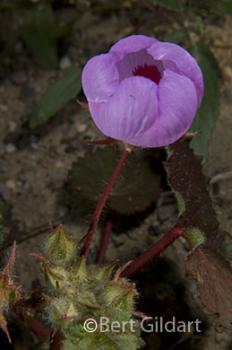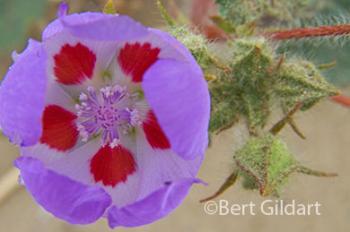Desert Five-Spot and the Function of Beauty

Petals obscure spots
©Bert Gildart: Though I doubt that the birds, the bears, and all the other wild things that inhabit the planet were put here for our purpose their presence does provide me with considerable satisfaction.
But their existence provides even more pleasure when I discover some feature contained in one of these living things whose functionality is not immediately obvious, appearing more aesthetic than utilitarian.
Such is the case with the desert five-spot. Why, I have to wonder, does each of the purple petals contain a crimson spot, revealed only under certain conditions? Certainly, the combination is beautiful to behold, but the plant’s reluctance to reveal its inner nature is what makes them particularly interesting.
HINT OF INNER BEAUTY
Several days ago I found the species to which I’ve just alluded, though its petals were closed tightly, so its identification was not immediately apparent to a desert novitiate such as myself. The flower was small, growing low–and obscured to some extent by the desert gold which towered above them.
I discovered the plant late in the late afternoon, but the burgundy spots were embraced tightly by the sepals and the petals and so not obvious.
Nevertheless, the whole of the flower was beautiful in itself, and because I wanted a photographic record of its existence I was more concerned at the moment about techniques than about the plant’s botanical aspects. Consequently, with Janie’s help, we held strobes off to either side and so eliminated the shadows, as shown here. (On sunny days that’s something you have to do if you want to see a plant’s lovely features.)
But later in the day when I examined the photo I saw the hint of a brilliant spot and began to think more about the plant, growing as it was in this harshest of all desert environments.
FIVE SPOTS AND THEIR FUNCTION
In Death Valley, this purple-colored plant was growing at an elevation of 180 feet below sea level, and our botany book, with its pages of plants grouped according to color, helped us confirm its I.D.
The book placed desert five-spot in the Mallow family, and briefly explained that not only did the one petal contain a spot, but that all five petals contained a spot and that the plant sometimes opened up and revealed its inner personality in the soft light of mid morning. The trick then was timing.

Open petals reveal hidden beauty
Yesterday, I returned to the area of my first discovery and did so on a day that was overcast. Searching the harsh rocky landscape, I quickly discovered that many desert five-spot plants dotted the floor and that the petals had in fact opened sufficiently to reveal that each petal contained a relatively large spot, somewhat oval and notched in appearance.
What purpose could they serve?
Casting around for an explanation I watched as several tiny insects crawled to the spot and I concluded the spots had to contain nectar. Because my wildflower I.D. book was just that I later confirmed with a park naturalist that the spots did indeed attract insects. As insects feasts on the nectar they come in contact with the stigmas and the anthers and become pollinators. In other words, the spots evolved to help the species perpetuate itself.
That thought was satisfying to me, for I’m confident the plant will be here another year; for my enjoyment, certainly, but more because of its dominion over all the other creatures that survive–because they survive. And that’s something I value even more.


February 22nd, 2017 at 1:22 am
Thanks for sharing your thoughts about nature photography. Regards